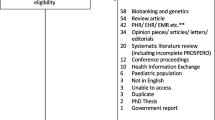Abstract
BACKGROUND: Federal laws and regulations, including the Health Insurance Portability and Accountability Act (HIPAA) of 1996, intended primarily to protect individuals, have been described as significant barriers to the use of clinical registries and other population-based tools for health care research. Although these regulations allow for the waiver or alteration of usual consent procedures when the research meets certain specific criteria, waivers and alterations are rarely used in health care research.
METHODS: The Vermont Diabetes Information System is a multistate randomized trial of a quality improvement intervention that uses a novel alteration of informed consent to help ensure that the study sample is representative of the target population. Patients are notified by mail that they are eligible for the study and that they may opt out of the study, if they desire, by calling a toll-free number.
RESULTS: Seven thousand five hundred and fifty-eight patients were invited to participate. Two hundred and ten (2.8%) opted out. Three patients (0.04%) filed complaints, all of which were addressed satisfactorly.
CONCLUSIONS: Health Insurance Portability and Accountability Act and other federal regulations raise challenges to the use of clinical registries in research, but modifications to the consent process, including passive consent methods, are useful tools to overcome these challenges. It is possible to recruit a broad and representative population under current law while maintaining appropriate protections for research subjects.
Similar content being viewed by others
References
Wadman M. US privacy laws may curb access to medical data. Nature. 1997;386:533.
Kulynych J, Korn D. The new federal medical—privacy rule. N Engl J Med. 2002;347:1133–4.
Rosenfeld CR. Medical privacy and medical research. N Engl J Med. 2002;346:1674.
Annas GJ. HIPAA regulation—a new era of medical-record privacy? N Engl J Med. 2003;345:1486–90.
McWilliams R, Hoover-Fong J, Hamosh A, Beck S, Beaty T, Cutting G. Problematic variation in local institutional review of a multicenter genetic epidemiology study. JAMA. 2003;290:360–6.
O’Herrin JK, Fost N, Kudsk KA. Health Insurance Portability Accountability Act (HIPAA) regulations: effect on medical record research. Ann Surg. 2004;239:772–8.
Armstrong D, Kline-Rogers E, Jani SM, et al. Potential impact of the HIPAA privacy rule on data collection in a registry of patients with acute coronary syndrome. Arch Intern Med. 2005;165:1125–9.
Tu JV, Willison DJ, Silver FL, et al. Impracticability of informed consent in the registry of the Canadian stroke network. N Engl J Med. 2004;350:1414–21.
Busby A, Ritvanen A, Dolk H, et al. Survey of informed consent for registration of congenital anomalies in Europe. BMJ. 2005;331:140–1.
MacLean CD, Littenberg B, Gagnon G, Reardon M, Turner PD, Jordan C. The Vermont Diabetes Information System (VDIS): study design and subject recruitment for a cluster randomized trial of a decision support system in a regional sample of primary care practices. Clin Trials. 2004;1:532–44.
Bodenheimer T, Wagner EH, Grumbach K. Improving primary care for patients with chronic illness. JAMA. 2002;288:1775–9.
Bodenheimer T, Wagner EH, Grumbach K. Improving primary care for patients with chronic illness: the chronic care model, Part 2. JAMA. 2002;288:1909–14.
Vermont Program for Quality in Health Care. Recommendations for Management of Diabetes in Vermont. Montpelier: VPQH; 2004.
American Diabetes Association. American diabetes association clinical practice recommendations. Diabetes Care. 2004;27(suppl 1):S1-S150.
Clark AM, Jamieson R, Findlay IN. Registries and informed consent [letter]. N Engl J Med. 2004;351:612–3.
Dziak K, Anderson R, Sevick MA, Weisman CS, Levine DW, Scholle SH. Variations among Institutional Review Board reviews in a multisite health services research study. Health Serv Res. 2005;40:279–90.
Wichman A, Sandler AL. Institutional review boards. In: Gallin JI, ed. Principles and Practice of Clinical Research. San Diego: Academic Press; 2002:52.
Public Health Service. Health Services Research and the HIPAA Privacy Rule. Available at: http://privacyruleandresearch.nih.gov/pdf/HealthServicesResearchHIPAAPrivacyRule.pdf. Accessed July 11, 2005.
Author information
Authors and Affiliations
Corresponding author
Additional information
This work was funded by the National Institute of Diabetes and Digestive and Kidney Diseases (R01 DK61167 and K24 DK068380).
Rights and permissions
About this article
Cite this article
Littenberg, B., MacLean, C.D. Passive consent for clinical research in the age of HIPAA. J Gen Intern Med 21, 207–211 (2006). https://doi.org/10.1111/j.1525-1497.2006.00339.x
Received:
Revised:
Accepted:
Issue Date:
DOI: https://doi.org/10.1111/j.1525-1497.2006.00339.x




